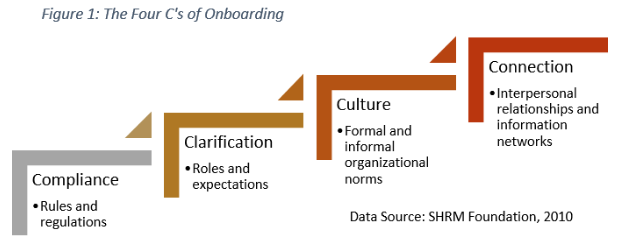
When software vendors first introduced onboarding in the cloud in the late 2000s, they were merely content and task management tools, but even that was a big step forward. For many of our colleagues, it helped shift the focus from administrative details to people.
The marketing and consulting efforts in onboarding over the past decade have fueled a supercharged interest in onboarding practices that have little to do with software. In fact, you can have an effective onboarding program without automation—if you can manage the administration.
Components of Onboarding
One of our gray-haired colleagues described his assimilation into an HR organization in 2001. John’s story shows how an HR department in an organization of 9,000 employees expressed its commitment to newcomers. It shows us how an onboarding process focused on assimilation and development results in better performance. He suggested his experience as a model for effective onboarding.
- Introduce the team before the first day of work. The interview process included a tour of the work area and informal conversations with the people on the team. (John learned later that their approval was required.)
- Initiate a personal welcome. Immediately after he accepted the offer, the team manager called to welcome him. An HR representative called to tell him exactly what to expect, where to go, and what to do in the days leading up to his start date.
- Remove first-day jitters. The HR rep gave him complete information on how to dress, where to report, and what to bring with him. She told him lunch would be provided. She remained in contact and answered his questions quickly.
- Make the first day a social occasion. After a one-on-one signing session with an HR rep, John endured the standard “here’s what you need to know” presentations, most of which were interactive and informative. Lunch was a celebration with his new team and a few key people in the organization he needed to know. His workstation was ready for him, with all the tools he needed.
- Set clear expectations. The manager described the learning path and performance expectations, and set milestones for development. John’s team leader gave him his personal set of reference materials and resources on everything from statutes and regulations to job evaluations.
- Use frequent feedback to assimilate and develop. John’s team leader/coach led him through a year-long assimilation into the work structure, the organization, and the depths of the essential body of knowledge. She led him through a series of assignments of increasing responsibility. He participated in team decisions and led projects from the beginning of his tenure. He had frequent progress reviews, always with a focus on the future.
- Celebrate achievement. The end of the training period was another celebration and the gift of his own portfolio of organizational units to support.
/Data_Sheets%20Resource%20Home%20page%20images/D17_HCM_Payroll_resource.png?width=264&name=D17_HCM_Payroll_resource.png)
Why You Need Onboarding Automation
Our colleague’s experience can also help us understand why you need automation. While the intent and department culture supported assimilation, administration was difficult. Here are the most troublesome difficulties administrators faced.
- Non-compliance. Since new hire paperwork was decentralized, it was hard to track compliance of items like I-9s. Every incoming file had to be audited, and no one could be sure what was in records. When the only indicator a required form was completed is hidden away in musty employee archives, how could you know?
- In was Inefficient. The department was buried in checklists. Nobody trusted them.
- It wasn’t scalable. The practices he described were not organization-wide. The culture existed only in his department. No mechanisms existed to extend these practices to other parts of the organization, except those who were willingly influenced by example.
Even if your automated onboarding is only task management, it still has value. But if you want your organization to move beyond the basics to the kind of program that affects the top and bottom lines, you need more.
Next Generation Onboarding
In a 2010 SHRM report, Talya Bauer presented the four C’s framework for evaluating employee onboarding programs. She uses her model to assess an organization’s onboarding maturity, taking new hire development beyond administration and acculturation to the relationships connections that make people and teams effective.[1]

Bauer’s work is relevant today. The nature of work is changing. The top-down hierarchical business models do not move quickly enough to be competitive in today's’ business environment. Innovations in organizational design are re-creating flatter, more responsive organizations consisting of cross-functional teams of teams.
Connection Technology
Onboarding vendors now provide the communications your people need to develop into connected employees. Talent management suites include embedded links to the activities that support the onboarding plan, and solutions that are not mobile-enabled have become rare.
- Embedded connections to continuous performance feedback tools strengthen the relationship between employee and manager.
- Embedded learning and development delivers just-in-time learning at the point of need.
- Collaboration tools linked to onboarding facilitate team activities and team management. Many of these include team feedback mechanisms.
Consider Your Options
If your onboarding solution doesn’t have these communication tools, you may not need to throw it out. Investigate first whether you can use integration tools to coordinate them with onboarding. With the current standardized methods of connecting applications, you may find it is much easier than you think.
References:
1. Bauer, Talya N., PhD. "Onboarding New Employees: Maximizing Success." SHRM Foundation. 2010.
Pixentia is a full-service technology company dedicated to helping clients solve business problems, improve the capability of their people, and achieve better results.


